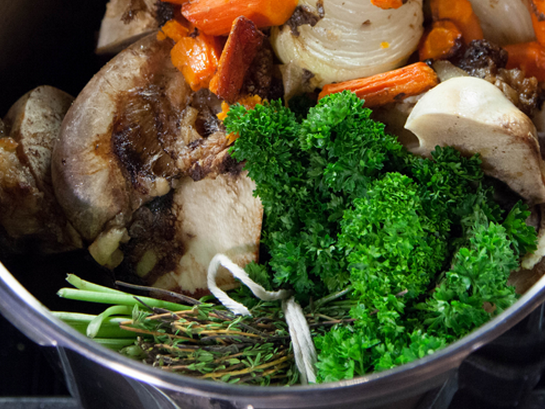A good recipe is created with a foundation of great ingredients. Sure, many things can be corrected with enough butter and cream, but the best way to ensure a delicious final dish is to make sure that everything going into it tastes delicious along the way.

Photo via James Peterson
Seems pretty simple, but I’ll be the first to admit that I often use boxed stock — nothing wrong with that — but I’m not sure I’ve ever tasted it on its own. I just throw it into the pot and hope for the best.
When I create my own stock, the resulting dish tastes much better.
Partly, perhaps it’s because I know of the work that went into making the stock (which really isn’t much) but mostly I know it’s because homemade stock is just plain better than the boxed variety. Whatever the reason, if time and ingredients allow for it, I love the satisfaction of making homemade stock.

How to make chicken stock
My favorite thing about making stock — chicken, vegetable, beef, etc. — is that there is no need to follow a recipe.
There are two methods for making a chicken stock.
1. Using a fresh, uncooked bird.
2. Using a spent carcass from, say, last night’s roasted chicken dinner.
I’ve made both with great success. Whichever route you embark on, the basics are the same.

Step 1:
Add aromatics to the pot. This is the time to use that unsightly onion bits that you’ve collected, or the bruised and slightly bitter outer celery stalks that preserve the sweet, interior ones. Also add herbs stems, carrot stubs, fennel fronds, etc. Of course, if you don’t save all those scraps and bits (which can be stored in the freezer for your next stock making escapades), using a roughly chopped fresh version is great too, and what I often use being the poor saver of scraps that I am.

For one chicken I usually use 1 large onion, roughly chopped, 3-4 stalks celery and the same amount of carrots. If I have fennel lying around, I’ll use that too.

Step 2:
Add some spices too. At the very least peppercorns. Beyond that, you can add bay, chili flakes, coriander, cumin, etc. This can also be added to the soup or recipe later.
Step 3:
Add the chicken, fresh or roasted. Cover with water.
Step 4:
Bring to a rolling boil then reduce the heat and simmer for 4 hours.

Step 5:
Strain out the spent vegetables.
Step 6:
Refrigerate the stock then skim off the layer of fat that rests at the top. Reserve that and use for cooking.
Chicken stock will keep in the fridge for one week or in the freezer for 3 months.
Use the chicken stock as a base for soups, for risotto, gravy and more.

Learn more about stocks and master sauces in this the Craftsy class A Modern Take on the Mother Sauces, taught by James Peterson.

Share tips, start a discussion or ask one of our experts or other students a question.
No Responses to “Savory Saturday: The Basics of Homemade Chicken Stock”